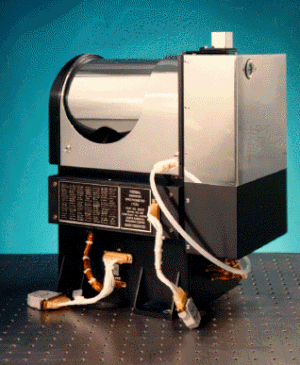Thermal Emission Spectrometer
Thermal Emission Spectrometer (TES) is an instrument used to measure the thermal infrared radiation emitted by objects, which is primarily used in the fields of astronomy, planetary science, and geology. The TES works on the principle that all objects emit heat in the form of infrared radiation, and the characteristics of this radiation can reveal a lot about the object's composition, temperature, and surface features.
Overview[edit | edit source]
The Thermal Emission Spectrometer operates by detecting the infrared energy emitted from a surface. This energy is directly related to the surface's temperature and emissivity, which is the efficiency with which an object emits infrared radiation. By analyzing the spectrum of this energy, scientists can infer the mineralogical composition of the emitting surface, as different minerals emit and absorb infrared radiation at different wavelengths.
Applications[edit | edit source]
TES instruments have been widely used in various space missions to study the surfaces of planets and moons in our solar system. One of the most notable applications of TES technology was on the Mars Global Surveyor (MGS) mission, which orbited Mars from 1997 to 2006. The TES instrument aboard MGS provided detailed information about the Martian surface's mineral composition, leading to significant discoveries about the planet's past environment and climate.
In addition to planetary science, TES technology is also used in geology for mapping mineral deposits on Earth and in environmental science for monitoring soil and vegetation health. The ability of TES to provide temperature and emissivity data makes it a valuable tool for studying global warming and environmental changes.
Technical Aspects[edit | edit source]
A typical Thermal Emission Spectrometer consists of a telescope to collect infrared radiation, a spectrometer to disperse this radiation into its component wavelengths, and a detector to record the spectrum. The spectrometer usually operates in the mid to far-infrared range, where most minerals have distinctive absorption and emission features.
The data collected by TES instruments require complex processing to extract meaningful information. This involves correcting for atmospheric effects, calibrating the instrument's response, and applying models to interpret the spectral data in terms of surface mineralogy and temperature.
Challenges[edit | edit source]
One of the main challenges in using TES instruments is the need to separate the temperature and emissivity effects in the thermal infrared spectrum. This is because both temperature and mineral composition influence the spectrum, and disentangling these effects requires sophisticated algorithms and models.
Another challenge is the atmospheric interference, especially for Earth-based or Earth-orbiting TES systems. The atmosphere absorbs and emits infrared radiation, complicating the detection and analysis of surface emissions. This requires atmospheric correction techniques to ensure accurate surface temperature and emissivity measurements.
Future Directions[edit | edit source]
Advancements in TES technology continue to expand its applications and improve its accuracy. Future developments may include enhanced spectral resolution, better temperature and emissivity separation techniques, and integration with other remote sensing technologies for more comprehensive environmental and planetary studies.
| Thermal Emission Spectrometer Resources | |
|---|---|
|
|
Search WikiMD
Ad.Tired of being Overweight? Try W8MD's physician weight loss program.
Semaglutide (Ozempic / Wegovy and Tirzepatide (Mounjaro / Zepbound) available.
Advertise on WikiMD
|
WikiMD's Wellness Encyclopedia |
| Let Food Be Thy Medicine Medicine Thy Food - Hippocrates |
Translate this page: - East Asian
中文,
日本,
한국어,
South Asian
हिन्दी,
தமிழ்,
తెలుగు,
Urdu,
ಕನ್ನಡ,
Southeast Asian
Indonesian,
Vietnamese,
Thai,
မြန်မာဘာသာ,
বাংলা
European
español,
Deutsch,
français,
Greek,
português do Brasil,
polski,
română,
русский,
Nederlands,
norsk,
svenska,
suomi,
Italian
Middle Eastern & African
عربى,
Turkish,
Persian,
Hebrew,
Afrikaans,
isiZulu,
Kiswahili,
Other
Bulgarian,
Hungarian,
Czech,
Swedish,
മലയാളം,
मराठी,
ਪੰਜਾਬੀ,
ગુજરાતી,
Portuguese,
Ukrainian
Medical Disclaimer: WikiMD is not a substitute for professional medical advice. The information on WikiMD is provided as an information resource only, may be incorrect, outdated or misleading, and is not to be used or relied on for any diagnostic or treatment purposes. Please consult your health care provider before making any healthcare decisions or for guidance about a specific medical condition. WikiMD expressly disclaims responsibility, and shall have no liability, for any damages, loss, injury, or liability whatsoever suffered as a result of your reliance on the information contained in this site. By visiting this site you agree to the foregoing terms and conditions, which may from time to time be changed or supplemented by WikiMD. If you do not agree to the foregoing terms and conditions, you should not enter or use this site. See full disclaimer.
Credits:Most images are courtesy of Wikimedia commons, and templates Wikipedia, licensed under CC BY SA or similar.
Contributors: Prab R. Tumpati, MD

